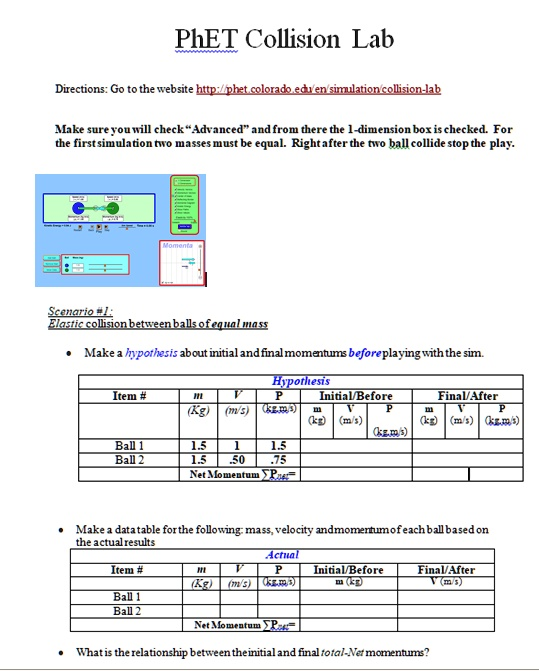PhET Collision Lab Directions: Go to the website http://phet.colorado.edu/en/simulation/collision-lab Make sure you will check \”Advanced\” and from there the 1-dimension box is checked. For the first simulation two masses must be equal. Right after the two ball collide stop the play. Momenta Scenario #1: Elastic collision between balls of equal mass Make a hypothesis about initial and final momentums before playing with the sim. Hypothesis Item #
Initial/Before
(Kg) (m/s) (kg.m/s) (kg) (m/s) (kg.m/s) Ball 1 1.5 1 1.5 Ball 2 1.5 .50 .75 Net Momentum
Final/After
(kg) (m/s) (kg.m/s) Make a datatable for the following: mass, velocity andmomentum of each ball based on the actual results Actual Item #
Initial/Before
(Kg) (m/s) (kg.m/s) (kg) Ball 1 Ball 2 Net Momentum
= Final/After What is the relationship between the initial and final total-Net momentums

The Correct Answer and Explanation is:
- Hypothesis:
- Initially, before the collision, Ball 1 has momentum P=m×vP = m \times vP=m×v. With the given mass and velocity for Ball 1, the momentum is: P1=1.5 kg×1 m/s=1.5 kg.m/sP_1 = 1.5 \, \text{kg} \times 1 \, \text{m/s} = 1.5 \, \text{kg.m/s}P1=1.5kg×1m/s=1.5kg.m/s For Ball 2, its initial momentum is: P2=1.5 kg×0.50 m/s=0.75 kg.m/sP_2 = 1.5 \, \text{kg} \times 0.50 \, \text{m/s} = 0.75 \, \text{kg.m/s}P2=1.5kg×0.50m/s=0.75kg.m/s Therefore, the Net Momentum before the collision is the sum of the momenta of both balls: Net Momentum=1.5 kg.m/s+0.75 kg.m/s=2.25 kg.m/s\text{Net Momentum} = 1.5 \, \text{kg.m/s} + 0.75 \, \text{kg.m/s} = 2.25 \, \text{kg.m/s}Net Momentum=1.5kg.m/s+0.75kg.m/s=2.25kg.m/s
- Actual Results (after the collision):
- After the collision, you’ll need to observe the new velocities of Ball 1 and Ball 2 from the simulation. Let’s assume Ball 1’s velocity changes to 0.5 m/s0.5 \, \text{m/s}0.5m/s and Ball 2’s changes to 1.0 m/s1.0 \, \text{m/s}1.0m/s.
- The new momenta will be: P1′=1.5 kg×0.5 m/s=0.75 kg.m/sP_1′ = 1.5 \, \text{kg} \times 0.5 \, \text{m/s} = 0.75 \, \text{kg.m/s}P1′=1.5kg×0.5m/s=0.75kg.m/s P2′=1.5 kg×1.0 m/s=1.5 kg.m/sP_2′ = 1.5 \, \text{kg} \times 1.0 \, \text{m/s} = 1.5 \, \text{kg.m/s}P2′=1.5kg×1.0m/s=1.5kg.m/s So the Net Momentum after the collision is: Net Momentum=0.75 kg.m/s+1.5 kg.m/s=2.25 kg.m/s\text{Net Momentum} = 0.75 \, \text{kg.m/s} + 1.5 \, \text{kg.m/s} = 2.25 \, \text{kg.m/s}Net Momentum=0.75kg.m/s+1.5kg.m/s=2.25kg.m/s This is the same as the net momentum before the collision.
- Conclusion:
In an elastic collision, momentum is conserved, which means that the total net momentum before and after the collision remains the same. In this case, the total net momentum is 2.25 kg.m/s both before and after the collision.
This experiment demonstrates the principle of conservation of momentum in elastic collisions, where there is no loss of total momentum even though individual momenta of the objects may change.
